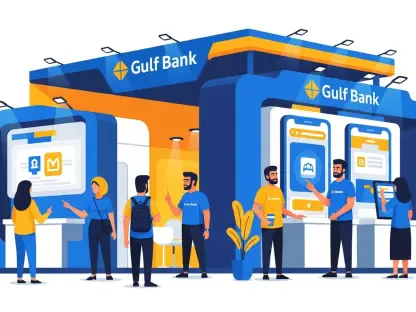Emerging trends in digital banking are capturing the attention of industry leaders globally, especially as embedded finance continues to transform how financial services are integrated into daily life. The launch of Salt Bank, under the leadership of Gabriela Nistor, provides an illustrative case study. The bank’s approach, grounded in an understanding of where modern finance and technology intersect, highlights its deployment as a cloud-native and embedded-first entity. Born from the robust umbrella of Banca Transilvania, Salt Bank differentiates itself with modern licenses, infrastructure, and an independent corporate culture. The bank’s operations deviate from traditional methodologies by embedding fintech at its core, marking a pivotal shift toward a seamlessly integrated financial ecosystem.
Salt Bank’s Embedded Finance Strategy
Integrating Fintech and Banking
Salt Bank is at the forefront of integrating fintech into the fabric of its operations, setting a benchmark for others in the industry. By intertwining financial services with broader systems, the bank ensures that customers and businesses alike enjoy unparalleled convenience and efficiency. This embedded approach extends beyond trendy practices, embodying a core strategy that positions the bank for long-term success. It prioritizes scalability, agility, and an open architecture, which in turn facilitates meaningful collaborations with fintech industry players, developers, and startups. This integrative strategy has notably allowed Salt Bank to introduce its Buy Now, Pay Later (BNPL) service swiftly to meet new consumer demands without the protracted development times of traditional banks.
Further underscoring this strategy is Salt Bank’s focus on real-time architecture, which caters to modern consumer demands for immediacy and responsiveness. The rollout of these services is bolstered by a commitment to seamless onboarding processes, underscoring the value of a frictionless user experience. This experience is crafted by embedding financial services—inherent to the bank’s culture—from the inception of its platforms and products. The bank’s strategy signals a movement toward banking-as-a-service, not just as a temporary fad but as a foundational principle for future growth and evolution. This repositioning from a static product to a dynamic platform allows Salt Bank to adapt to both anticipated and unforeseen changes in the financial landscape.
Human Element in Digital Banking
Amidst advanced technologies and automation, Salt Bank remains committed to revitalizing the human element in digital banking. The institution’s ethos reflects a balance between maintaining state-of-the-art technology and infusing human touchpoints into its digital interactions. This approach promotes customer trust and satisfaction, which is crucial for expanding its user base. By tailoring its automated systems toward enhancing rather than replacing human interaction, Salt Bank has rapidly achieved impressive customer acquisition rates and a high Net Promoter Score. These achievements evidence the bank’s dedication to not just meeting but exceeding customer expectations through meaningful engagement.
Equally important is the bank’s emphasis on customer support, a critical pillar in garnering trust and loyalty in digital banking. Unlike banks that might automate beyond necessity, Salt focuses on ensuring that user queries and concerns are addressed with immediacy and empathy. This dual focus on technology and empathy creates a differentiating factor, establishing a brand perception that respects and values the customer. Salt’s rapid customer acquisition reflects the success of this human-centered approach, reinforcing the essential role that personalized customer service plays, even in technology-heavy environments. As the digital landscape evolves, keeping human interactions at the core of its offerings is both a strategy and a philosophy for sustainable growth.
Gabriela Nistor’s Leadership and Vision
Pioneering in a Male-Dominated Industry
Gabriela Nistor stands as a formidable leader demonstrating exemplary leadership in a traditionally male-dominated banking environment. Her ascendancy in the industry is not merely a product of breaking glass ceilings but revolves around cultivating a dynamic and inclusive culture within Salt Bank. She attributes much of this success to a team that seamlessly blends banking acumen with fintech innovation. Under her leadership, Salt Bank executes projects with precision, characterized by a culture that values decisive action alongside robust communication. By actively listening and delegating responsibilities to capable team members, Nistor ensures that the best ideas always rise to the forefront, crafting a culture that prizes execution over bureaucracy.
The trajectory of Nistor’s leadership emphasizes an agile structure capable of real-time innovation and adaptation. Her distinct style integrates clear communication channels with decisive judgments, allowing for swift navigation through challenges. By prioritizing diverse skill sets and perspectives, she not only fortifies the bank’s strategic positioning but also ensures its resilience in a fluctuating digital landscape. Nistor’s leadership extends beyond Salt Bank, serving as a transformative example for the fintech industry, highlighting the potential for effective, diverse leadership in shaping the future of digital banking.
Expansion and Future Directions
Looking to the future, Salt Bank’s evolution is poised to continue at an accelerated pace, driven by expanding its suite of financial offerings. New initiatives are on the horizon, such as the launch of accounts specifically tailored for SMEs and the strategic deployment of embedded lending solutions. These efforts aim to increase accessibility to cutting-edge financial infrastructure, ensuring that institutions of all sizes can participate in the digital economy. The commitment to expanding services reflects Salt Bank’s vision for fostering inclusivity and engagement across diverse customer segments.
To sustain its innovative momentum, Salt Bank remains cognizant of changing market demands and digital advances. The focus on developing partnerships that leverage its robust digital platform will be pivotal in maintaining its competitive edge. Salt Bank’s ongoing evolution represents not just a gradual scaling of operations, but a commitment to reimagining the future of digital banking altogether. As it aligns its strategies with future trends, the bank emerges as an agile entity capable of navigating the evolving digital landscape with foresight and fluidity. Salt Bank’s continued innovation affirms its status as a pioneering institution in the digital banking sector.
Innovations Shape the Future
Salt Bank stands out by integrating fintech into its core operations, setting a standard for the industry. By aligning financial services with extensive systems, it offers exceptional convenience and efficiency for customers and businesses. This integration isn’t just a trend; it’s a strategic priority aimed at ensuring long-term success. The bank focuses on scalability, agility, and open architecture, which supports collaboration with fintech players, developers, and startups. This approach enabled Salt Bank to launch its Buy Now, Pay Later (BNPL) service quickly, addressing consumer demands without lengthy traditional bank timelines.
Salt Bank’s commitment to real-time architecture meets modern needs for immediacy and responsiveness. A seamless onboarding process highlights the value placed on a smooth user experience, embedded in the bank’s culture from the beginning. Salt Bank is moving toward banking-as-a-service as a foundational strategy for future growth. By transitioning from static products to a dynamic platform, it can adapt to anticipated and unforeseen changes in the financial world.









